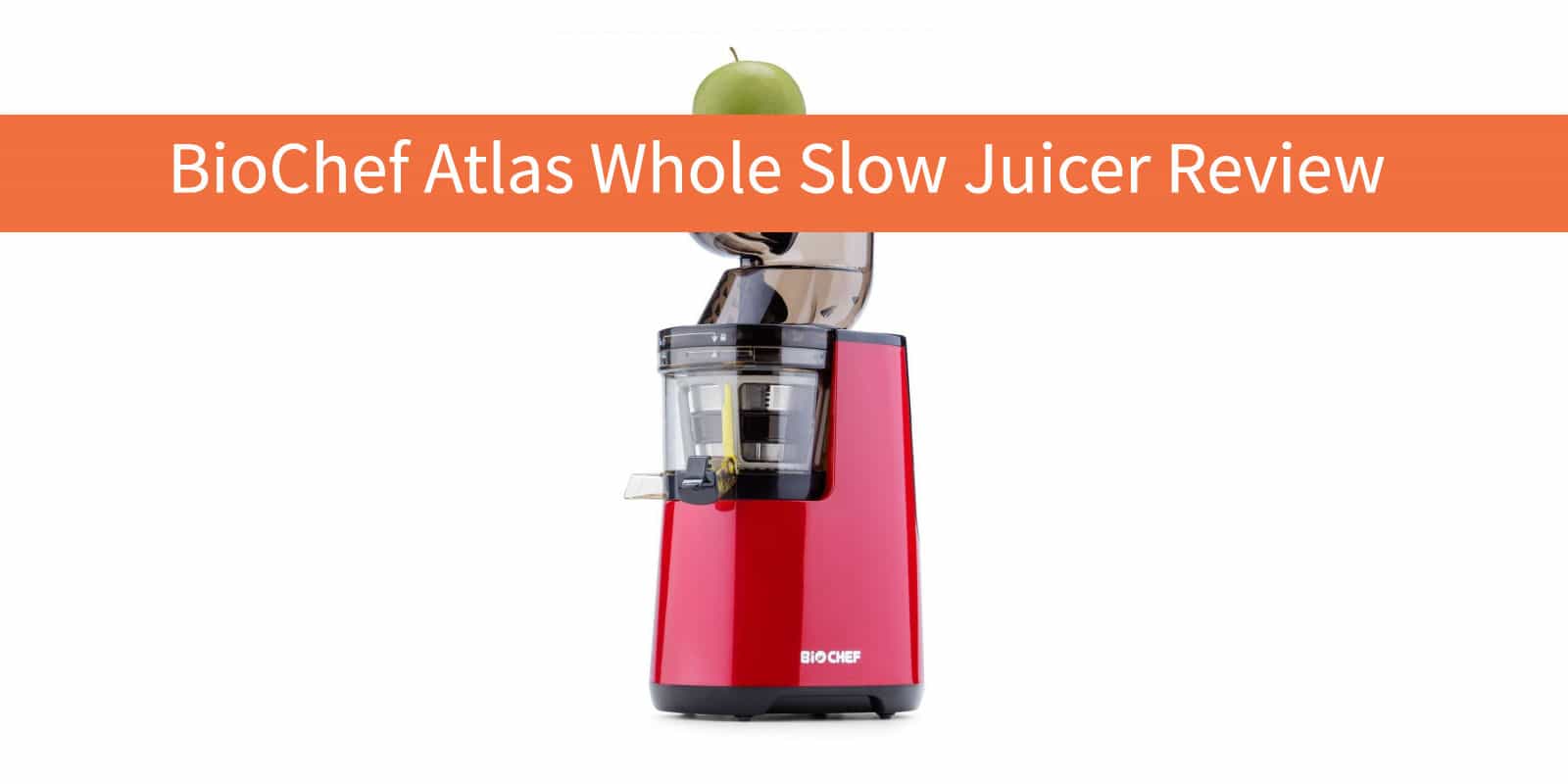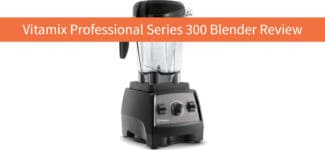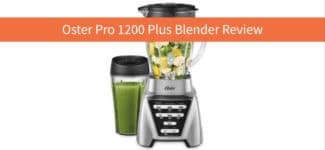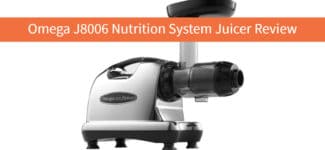What Is the BioChef Atlas Whole Slow Juicer?
With so many options to choose from, it’s sometimes hard to decide on which juicer to get!
And, hey, it can’t help but get more blurry when you’re thinking about a certain juicer, only to find out it has what seems like identical clones with different brand names.
Recently, I’ve been curious about three vertical masticating slow juicers:
- The BioChef Atlas Whole Slow Juicer;
- Oscar Neo XL 400; and
- Optimum 700 Advanced
The three of them share a very close design pattern.
However, as far as my research goes, they don’t score the same despite what appears as subtle differences.
I also wanted to do a deep dive into each of these units because you can’t always trust comparison videos to be fair and unbiased.
Let’s go over the BioChef Atlas Whole and see how it compares!
Video Overview
Product Details and Usage
| Product Specs | |
|---|---|
| Type | Masticating Juicer |
| Application | Home & Personal Use |
| Juice Quality | High |
| Juice Shelf Life | 48 Hours |
| Build | Plastic (BPA Free) |
| Design | Vertical |
| Chute Size | Large: 3.15 Inches Small: 1.37 x 1.77 Inches |
| Wattage | 250 Watts |
| Motor | 40 RPM |
| Noise Level | Low |
| Dishwasher Safe | No |
| Best for Juicing | Hard and Soft Produce, Citrus Fruits, Nuts |
| Warranty | Lifetime (Motor) 5 Years (Parts) |
Notable Product Features
- 250-watt motor rotates auger at a very slow 40 RPM, meaning little to no initial oxidation
- Very quiet motor, letting you juice when you want without disturbing anyone
- 2-in-1 wide feed chute tract adds convenience to juicing both bulky and long produce
- Two 35 oz. containers for juice and pulp collection
- Tritan BPA-free plastic construction
- Lifetime warranty on motor, 5 years on parts
Build Quality and Design
In case you weren’t aware, the BioChef Atlas Whole actually has a “small chute” cousin, the BioChef Atlas Slow Juicer.
But in response to customers requesting a juicer with a wider feed chute, the “Whole” version was developed.
With slight differences, the BioChef Atlas Whole features the same characteristic design you see with the Optimum 700 Advanced and Oscar Neo XL 400.
It’s available in four color variations: Black, red, silver, and white.
All parts coming in contact with food are BPA-free Tritan plastic.
With its vertical style design, it’s a horizontally compact juicer with a small footprint, clocking in at:
- 6.3 inches wide (16 cm)
- 17.7 inches tall (45 cm)
- 8.2 inches deep (20.8 cm)
- 15.4 pounds (7 kilograms)
Wide feed chute vertical juicers tend to be roughly 2-2.5 inches taller than vertical units with smaller chutes.
So, if you’re planning on placing this juicer on your kitchen countertop, remember this is a fairly tall appliance, so you’ll need to consider how much room you have between the countertop surface and kitchen cabinet.
The juicer’s feed has two openings:
- A large 3.15 inch opening for bulky produce and leafy greens
- A smaller opening intended for dropping lengthy produce straight down to the auger
This 2-in-1 style tract optimizes the juicer for both types of produce and means you can often get away with not having to do any pre-cutting.
While you do get a food pusher, the intention behind vertical juicers is to let the auger and gravity, handle most of the work, without applying force.
The BioChef Atlas Whole comes with 3 strainers, giving you more control over pulp content and adds versatility to what you can make:
- A fine strainer to achieve smoother juice with as little pulp as possible
- A coarse strainer for making thicker consistencies (smoothies, sauces, purées, baby food, etc.)
- A sorbet strainer to make frozen fruit sorbets
To collect juice and pulp, you get two 35 oz. containers, which is adequate capacity to make juice for two people without interruption.
You also get a sieve attachment for the juice container, which further helps reduce pulp and fiber content.
The 16.9 fl. oz. juice bowl has a flow spout with a cap attachment, which comes in handy for letting ingredients mix thoroughly and to quickly rinse the juicer with water.
I’ve seen multiple reports from users saying the pulp ejection port is slightly too small, sometimes causing it to clog up while you’re juicing.
So bear in mind you may need to stop the juicer to manually remove the blockage.
If and when things break or go wrong with your BioChef Atlas Whole, the unit comes with a lifetime warranty on the motor and 5 years on parts.
But, as I’ve said about the other juicers with similar warranties:
The lifetime motor warranty IS impressive, sure, but as it stands with nearly every juicer worth buying, the motor is the LAST thing that ever breaks.
The parts are likely to break many times over before the motor gives in, so I always say I’d happily trade in the lifetime deal for a longer warranty on the parts.
This is why Omega’s 15-year warranties on the entire unit are by far more impressive.
Juice Quality and Yield
With a rotation speed of 40 RPM, the BioChef Atlas Whole yields juice with very little initial oxidation, hence a juice that can last longer, up to 48 hours refrigerated.
However, this juicer unfortunately doesn’t fare as well as the Oscar Neo XL 400 and Optimum 700 Advanced.
I’ve come across several reviewers saying the pulp is wetter than desired and the resulting juice is fairly pulpy, despite using the fine strainer and sieve attachment.
One distributors’ response to this said the BioChef Atlas Whole isn’t as efficient as BioChef’s horizontal style juicers at producing smooth and pulp-free juice, especially when it comes to fibrous and tough produce.
But I can share three quick tips to help reduce pulp content:
- Use the fine strainer and sieve attachment and consider getting a gravy separator as an effective strainer
- When juicing, don’t close the juice outlet cap otherwise the juice tends to be pulpier and the ejected pulp, wetter
Also, don’t add ingredients too quickly or force them down with the food pusher. Allow the juicer time to process what you put in.
From my experience and research in reviewing juicers, it seems that horizontal masticating juicers do a better job overall at producing juice with little to no pulp content.
But if you follow the tips above, you should get OK results from the BioChef Atlas Whole.
The next three issues worth highlighting is people having trouble juicing celery, leafy greens frequently getting stuck, and larger bits and pieces not being juiced and getting stuck inside the juicer.
Things like celery and chard stems have an interesting reputation for jamming or clogging vertical masticating juicers.
The only way around this is to cut them into very small pieces and remember to rotate the ingredients you drop in.
As for greens getting stuck, I do have to say that wide feed chute vertical juicers generally aren’t the ideal choice, and you should instead consider a smaller chute juicer.
If you’re looking to juice common staples like apples, carrots, citruses, cucumbers, grapes, mango, melons, papaya, peaches, pineapples, and tomatoes, you’ll be fine with this juicer.
But if you want a juicer that’s efficient with beetroots, celery, chard stems, baby greens, sprouts, and wheatgrass, there are better juicers for you to choose.
Wet pulp usually means the juicer wasn’t able to efficiently extract juice from your produce (of course, things like citruses generally leave a wetter pulp almost regardless of which juicer is used).
To avoid disappointment, you should expect the BioChef Atlas Whole to give yields comparable to or less than a decent centrifugal juicer.
Performance and Noise
This juicer features a 250-watt, quiet motor, rotating the auger screw at 40 RPM.
Some squeaking noises can happen from juicing beetroot, carrots, and parsnip. Apart from that, it’s a very quiet juicer you can freely use on mornings or late evenings without concern for disturbing others.
You can run the motor for 30 minutes at a time after which you should give it a break.
Keep in mind this is a “slow juicer,” so if you’re looking for 5-minute juicing sessions, you’ll be disappointed.
But the wide feed chute design helps make up for it by saving you time on pre-cutting most produce.
Is It Easy to Use?
Compared to small chute juicers, I’ve found these wide feed chute vertical juicers, the BioChef Atlas Whole included, to be slightly easier for beginners to get started with.
Other juicers often have a higher learning curve for you to get consistently good results and to avoid causing your juicer to jam frequently.
There’s more “technique” to learn, so to speak.
However, I’ll point out this juicer does cause more struggle than I’ve found with the Oscar Neo XL 400 and Optimum 700 Advanced models.
Assembling and disengaging the parts is pretty straightforward.
The first time, after unboxing the juicer, you might feel overwhelmed with all the parts.
But after the first two times, you’ll realize it’s easy.
Here’s a video on how to assemble and use the BioChef Atlas Whole:
Is It Easy to Clean?
After a typical juicing session, you’ll have about 8-9 parts to clean.
The parts on this juicer aren’t dishwasher safe, so you’ll need to wash and rinse each part by hand, which should take no longer than 5-7 minutes.
The toughest part to clean is usually the sieve attachment or juice strainers.
I always recommend you line the juice container with a plastic bag, which spares you 1 part to clean.
Also, you should start cleaning immediately after finishing to avoid things becoming sticky and tough to remove.
If you do this, you can simply give each part a good rinse with water, and use the supplied brush as needed.
When making different recipes in succession, you can:
- Place an empty container under the juice outlet
- Close the outlet’s cap attachment
- Switch on the juicer and pour about 3 cups of water into juice bowl
Let the water stir around for about 30 seconds, picking up leftover pulp and pieces, then drain the juice bowl into the empty container.
This saves you from having to pull apart the juicer after each recipe because you don’t want the flavors to mix.
How Does It Compare?
Let’s take a look at how this juicer compares with similar competitor models.
BioChef Atlas Whole vs. Oscar Neo XL 400 Whole Slow Juicer
The Oscar Neo XL 400 is slightly more expensive but, to me, the price difference is justifiable, especially if you want to use your juicer under commercial conditions.
It has a stainless steel outer casing as opposed to the BioChef Atlas Whole’s plastic build.
It has a commercial-grade motor with a higher wattage and warranty that covers commercial use.
While sharing some of the same weaknesses as the BioChef Atlas Whole with respect to celery, beetroot, and leafy greens, it does a slightly better job at producing juice with little pulp.
If slightly better performance or commercial use is what you’re after, this is the one you want.
BioChef Atlas Whole vs. Optimum 700 Advanced Cold Press Juicer
The Optimum 700 Advanced is markedly more expensive, so if budget is a concern, I would opt for a different juicer.
It has more of a premium feel with a beautiful design and handles produce better on average compared to the BioChef Atlas Whole.
It also has the same weaknesses with stringy produce and beetroot.
If modern and slick-looking design is what you’re after, the Optimum 700 Advanced wins.
Should I Buy the BioChef Atlas Whole Slow Juicer?
In all honesty, the BioChef Atlas Whole is tough to recommend wholeheartedly because I think there are better options, some of which I’ve already reviewed.
The sheer volume of user feedback you can find across the net highlighting very specific problems and challenges with this unit should warrant some caution.
If you use this juicer to juice beetroot, celery, and leafy greens, don’t expect to be amazed.
That aside, this juicer does work and can definitely get the job done. Just be certain you’ll use it for the produce it works best with and follow the tips I’ve shared with this review.







